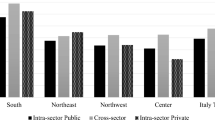Abstract
One of the major transitions in recent scientific research is the rise of network theory motivating a variety∈dexvariety of new research programmes in and across various disciplines. Economic geography∈dexgeography has been no exception. The work on networks in economic geography can be divided into two types of research. First, there are studies on inter-firm networks and their impact on firm performance. For a large part, such studies have been carried out in the context of geographical clusters, which are often characterised by strong network relations (Uzzi, 1997). A second approach, an example of which is presented below, concerns the study of inter-regional networks and their impact on regional growth. Here, the unit of analysis are territories, typically sub-national regions. The interest in this topic stems from Castells (1996) and others who have argued that regional growth increasingly depends on a region’s position in global networks rather than its specific local characteristics such as institutions, endowments and amenities (‘space of flows’ versus the ‘space of places’).
Access this chapter
Tax calculation will be finalised at checkout
Purchases are for personal use only
Preview
Unable to display preview. Download preview PDF.
Similar content being viewed by others
References
Barabasi AL., Albert R (1999) Emergence of scaling in random networks. Science 286(5439): 509–512
Barrat A, Barthelemy M, Vespignani A (2005) The effects of spatial constraints on the evolution of weighted complex networks. Journal of Statistical Mechanics Art. No. P05003
Bathelt H, Glückler J (2003) Toward a relational economic geography. Journal of Economic Geography 3: 117–144
Boschma RA (2005) Proximity and innovation. A critical assessment. Regional Studies 39(1): 61–74
Boschma RA., Frenken K (2006) Why is economic geography not an evolutionary science? Towards an evolutionary economic geography. Journal of Economic Geography 6(3): 273–302
Castells M (1996) The Rise of the Network Society. Blackwell: Oxford.
Edquist C, Johnson B (1997) Institutions and organisations in systems of innovations, in: Edquist C. (ed.) Systems of Innovation. Technologies, Institutions and Organizations. Pinter: London, pp. 41–63
Frenken K (2002) A new indicator of European integration and an application to collaboration in scientific research. Economic Systems Research 14(4): 345–361
Frenken K, Hoekman J, Van Oort F (2007) Towards a European Research Area (Rotterdam/The Hague: NAi Uitgevers/RPB),www.rpb.nl
Frenken K, Hölzl W, de Vor F (2005) The citation impact of research collaborations: The case of European biotechnology and applied microbiology (1988–2002). Journal of Engineering Management and Technology 22(1–2): 9–30
Gertler MS (2005) ‘Being there’: proximity, organization, and culture in the development and adoption of advanced manufacturing technologies. Economic Geography 71(1): 1–26
Guimerà R, Amaral LAN (2004) Modelling the world-wide airport network. European Physical Journal B 38 (2): 381–385
Katz JS (1994) Geographical proximity and scientific collaboration. Scientometrics 31: 31–43
Katz JS, Martin BR (1997) What is research collaboration? Research Policy 26 (1): 1–18
Liang LM, Zhu L (2002) Major factors affecting China’s inter-regional research collaboration: Regional scientific productivity and geographical proximity. Scientometrics 55 (2): 287–316
Long JS (1997) Regression Models for Categorical and Limited Dependent Variables. Advanced Quantitative Techniques in the Social Sciences, Volume 7. Sage publications: Thousand Oaks, CA
Luukkonen T, Tijssen RJW, Persson O, Sivertsen G (1993) The measurement of international scientific collaboration. Scientometrics 28: 15–36
Maggioni MA, Uberti TE (2007) International networks of knowledge flows: an econometric analysis. In: Frenken, K. (ed), Applied Evolutionary Economics and Economic Geography. Edward Elgar: Cheltenham UK, pp. 230–255
Maurseth P, Verspagen B (2002) Knowledge spillovers in Europe: a patent citation analysis. Scandinavian Journal of Economics 104(4): 531–545
Meyer M, Bhattacharya S (2004) Commonalities and differences between scholarly and technical collaboration. An exploration of co-invention and co-authorship analyses. Scientometrics 61: 443–456
Narin F, Stevens K, Whitlow ES (1991) Scientific cooperation in Europe and the citation of multinationally authored papers. Scientometrics 21(3): 313–332
Ponds R, Van Oort FG, Frenken K (2007) The geographical and institutional proximity of scientific collaboration networks. Papers in Regional Science 86: 423–443
Roy JR, Thill J (2004) Spatial interaction modelling. Papers in Regional Science 83: 339–361
Sen A, Smith TE (1995) Gravity Modelling of Spatial Interaction Behaviour. Springer: Berlin
Tinbergen J (1962) Sha** the world economy. Suggestions for an International Economic Policy. The 20th century fund: New York
Torre A, Rallet A (2005) Proximity and localization. Regional Studies 39(1): 47–59
Uzzi B (1997) Social structure and competition in interfirm networks: the paradox of embeddedness. Administrative Science Quarterly 42(1): 35–67
Verbeek A, Debackere K, Luwel M (2003) Science cited in patents: A geographic “flow” analysis of bibliographic citation patterns in patents. Scientometrics 58(2): 241–263
Wagner C, Leydesdorff L (2005) Map** the network of global science comparing international co-authorships from 1990 to 2000. International Journal of Technology and Globalization 1(2): 185–208
Wagner-Doebler R (2001) Continuity and discontinuity of collaboration behaviour since 1800 – from a bibliometric point of view. Scientometrics 52: 503–517
Author information
Authors and Affiliations
Corresponding author
Editor information
Editors and Affiliations
Rights and permissions
Copyright information
© 2009 Springer-Verlag Berlin Heidelberg
About this chapter
Cite this chapter
Frenken, K., Hoekman, J., Kok, S., Ponds, R., van Oort, F., van Vliet, J. (2009). Death of Distance in Science? A Gravity Approach to Research Collaboration. In: Pyka, A., Scharnhorst, A. (eds) Innovation Networks. Understanding Complex Systems. Springer, Berlin, Heidelberg. https://doi.org/10.1007/978-3-540-92267-4_3
Download citation
DOI: https://doi.org/10.1007/978-3-540-92267-4_3
Published:
Publisher Name: Springer, Berlin, Heidelberg
Print ISBN: 978-3-540-92266-7
Online ISBN: 978-3-540-92267-4
eBook Packages: Business and EconomicsEconomics and Finance (R0)




